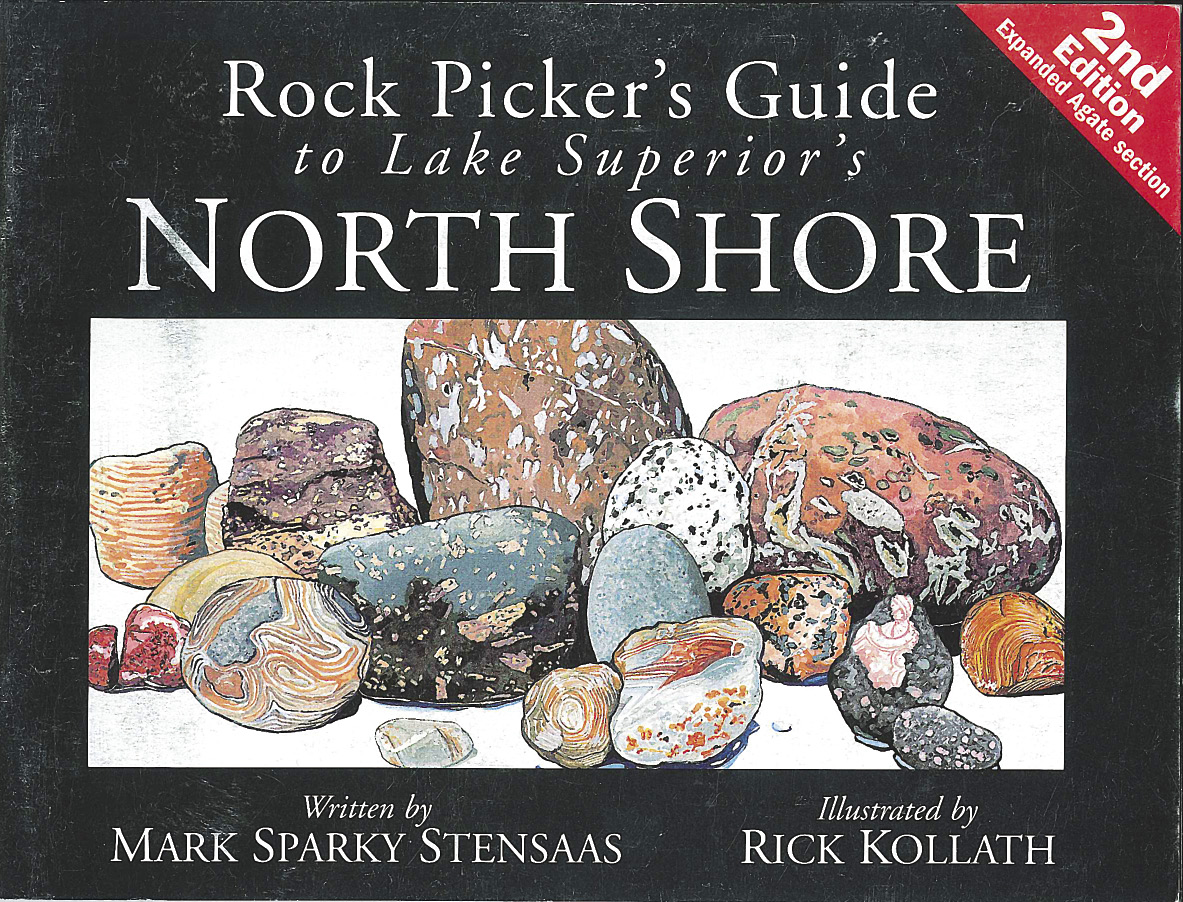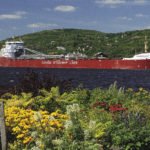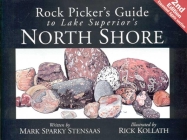
Chert & Chalcedony: Flint, Jasper, Carnelian
Most of us are familiar with quartz—the clear large crystalled rock. Now we move into tiny-grained quartz rocks known as microcrystalline quartzes. These rocks were formed from silica that was dissolved out of silica-rich minerals like quartz. The silica travelled as fine particles in water until settling as a gel in cracks and bubbles (vesicles) in the bedrock. Slowly, the water evaporated leaving only the microscopic quartz crystals of silica.
All microcrystalline quartz can be divided into two groups of rocks: chalcedony (translucent and glossy) and chert (opaque and waxy).
How to Recognize: Chalcedony rocks are nearly pure silica (SiO2) resulting in a translucent stone with a glossy to waxy surface. Examples include Lake Superior agate, red carnelian and yellow chalcedony. Cherts, on the other hand, have some impurities causing them to be less translucent and less glossy.
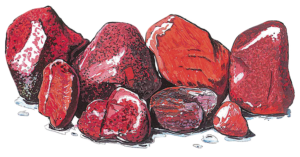 Though duller and opaque, cherts still come in a huge variety of colors from black (flint) to tan, yellow, gray and red (jasper). Jasper is stained with deep-burgundy sands of hematite (iron-bearing rock). With a little experience even tiny jasper nodules become very noticeable to the observant beachcomber. Their deep red/purple sheen is especially visible in the wave-splash zone at the Lake’s edge. Jasper may be “freckled” or wavy banded with varying shades of red and yellow. Chipped edges form half-moon shaped divots. This is called conchoidal fracturing and is a characteristic of all microcrystalline quartzes.
Though duller and opaque, cherts still come in a huge variety of colors from black (flint) to tan, yellow, gray and red (jasper). Jasper is stained with deep-burgundy sands of hematite (iron-bearing rock). With a little experience even tiny jasper nodules become very noticeable to the observant beachcomber. Their deep red/purple sheen is especially visible in the wave-splash zone at the Lake’s edge. Jasper may be “freckled” or wavy banded with varying shades of red and yellow. Chipped edges form half-moon shaped divots. This is called conchoidal fracturing and is a characteristic of all microcrystalline quartzes.
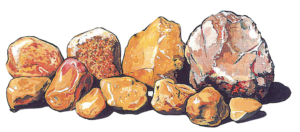 Where to Find: Jasper is most plentiful at Split Rock. Of the other cherts, tan is found at Kitchi Gammi while yellow shows up on the beaches of Burlington Bay, Flood Bay and Beaver River. Black chert, a.k.a. flint, is found on the Split Rock River Beach while banded flint is possible at Beaver River and Paradise Beach.
Where to Find: Jasper is most plentiful at Split Rock. Of the other cherts, tan is found at Kitchi Gammi while yellow shows up on the beaches of Burlington Bay, Flood Bay and Beaver River. Black chert, a.k.a. flint, is found on the Split Rock River Beach while banded flint is possible at Beaver River and Paradise Beach.
Four colors of chalcedony are out there to be discovered. Look for the clear form at Gooseberry Falls and Split Rock, yellow at Burlington Bay and Paradise Beach and smokey-gray amongst the basalts and rhyolites of Flood Bay. Eagle-eyed rock pickers may spot carnelian (red chalcedony) on Split Rock River Beach or
Paradise Beach.
Porphyry
A well-known landmark and a massive example of porphyritic rock is the United States’ first national monument, Devil’s Tower in Wyoming. It formed as a giant molten plug which didn’t quite make it to the surface of a volcano. The volcano eroded away, leaving just the plug.
 Porphyry is unique in that phenocrysts (whole crystals) of feldspars, quartzes or other minerals formed in still-molten magma before it erupted onto the surface. When the rock spewed out of the earth as lava, the matrix (the base rock; the stuff which was still molten while the crystals formed) hardened rapidly, forming a fine-grained rock trapping the large-grained phenocrysts. On the North Shore, the matrix rock can be either basalt or rhyolite. Porphyry is not the same as amygdaloidal rock.
Porphyry is unique in that phenocrysts (whole crystals) of feldspars, quartzes or other minerals formed in still-molten magma before it erupted onto the surface. When the rock spewed out of the earth as lava, the matrix (the base rock; the stuff which was still molten while the crystals formed) hardened rapidly, forming a fine-grained rock trapping the large-grained phenocrysts. On the North Shore, the matrix rock can be either basalt or rhyolite. Porphyry is not the same as amygdaloidal rock.
How to Recognize: You can easily tell phenocrysts and amygdules apart. Porphyritic phenocrysts are boxy and have angular squarish corners and edges. Amygdules form in bubbles so look for roundish mineral-filled shapes.
Where to Find: Rhyolite is everywhere and often porphyritic. Basaltic porphyries are much less common but represented on nearly every North Shore beach.
Lake Superior Agate
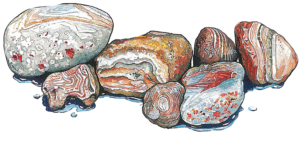 We are lucky that agate is harder than basalt or rhyolite. Why? Because if it was softer, the gargantuan grinding glaciers of the Pleistocene would have not only knocked them out of the basalt, but ground them to dust in the process. Fortunately for rock-hounds everywhere that wasn’t the case. What the glaciers did do, though, was to transport some Lake Superior agates well south of the Lake Superior basin. In fact, many were stranded in southern Minnesota and even Iowa when the glaciers retreated. Not only did the glaciers transport the agates but they also performed as giant rock tumblers, smoothing the rock’s rough edges. Agates on the North Shore were either brought south from Canada or weathered out of our bedrock naturally. Only after the agate is free of the base rock can be abraded and exposed to the air causing the iron-rich banding to turn red due to oxidization. (In other words…rusting.)
We are lucky that agate is harder than basalt or rhyolite. Why? Because if it was softer, the gargantuan grinding glaciers of the Pleistocene would have not only knocked them out of the basalt, but ground them to dust in the process. Fortunately for rock-hounds everywhere that wasn’t the case. What the glaciers did do, though, was to transport some Lake Superior agates well south of the Lake Superior basin. In fact, many were stranded in southern Minnesota and even Iowa when the glaciers retreated. Not only did the glaciers transport the agates but they also performed as giant rock tumblers, smoothing the rock’s rough edges. Agates on the North Shore were either brought south from Canada or weathered out of our bedrock naturally. Only after the agate is free of the base rock can be abraded and exposed to the air causing the iron-rich banding to turn red due to oxidization. (In other words…rusting.)
How to Recognize: Easiest to spot when wet. Agates will glisten in the sun. Beach finds are rarely bigger than a walnut and most are pistachio-sized or smaller. Finding them becomes second nature with practice. The alternating red and clear or white bands are distinctive. They are translucent and extremely hard. Even unbroken agate nodules can be easily identified by their lustrous, dimpled surface.
Where to Find: Almost any beach with small pebbles will hold agates and probably a prize or two. Remember, the waves of Lake Superior keep replenishing the stock so keep looking—especially after storms or early in the spring. The best and biggest Lake Superior agates are found on the dirt roads and gravel pits of Carlton County, Minnesota.
Basalt
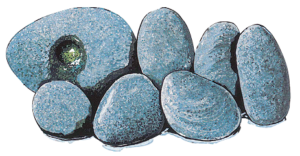 Basalt and rhyolite are by far the most common rocks you will find on Lake Superior’s North Shore beaches. Basalt is one of the four rock-types that make up the basement bedrock of the earth’s crust. Basically it is lava that cooled quickly on the surface. The faster lava cools the smaller the crystals are. Our basalt originated during the Precambrian era 1.1 billion years ago when North America tried to split right down the middle. Millions of tons of lava flowed out from the rifts depressing the land and forming the original basin of Lake Superior. Today as you drive along Highway 61 nearly ever cliff, ridge, rock cut or ledge you see originated from these ancient lava flows.
Basalt and rhyolite are by far the most common rocks you will find on Lake Superior’s North Shore beaches. Basalt is one of the four rock-types that make up the basement bedrock of the earth’s crust. Basically it is lava that cooled quickly on the surface. The faster lava cools the smaller the crystals are. Our basalt originated during the Precambrian era 1.1 billion years ago when North America tried to split right down the middle. Millions of tons of lava flowed out from the rifts depressing the land and forming the original basin of Lake Superior. Today as you drive along Highway 61 nearly ever cliff, ridge, rock cut or ledge you see originated from these ancient lava flows.
How to Recognize: Bluish-black with very small crystals. Can be found in all sizes and shapes from round to flat. An excellent skipping stone.
Where to Find: Any and every beach on the North Shore.—Mark Sparky Stensaas


